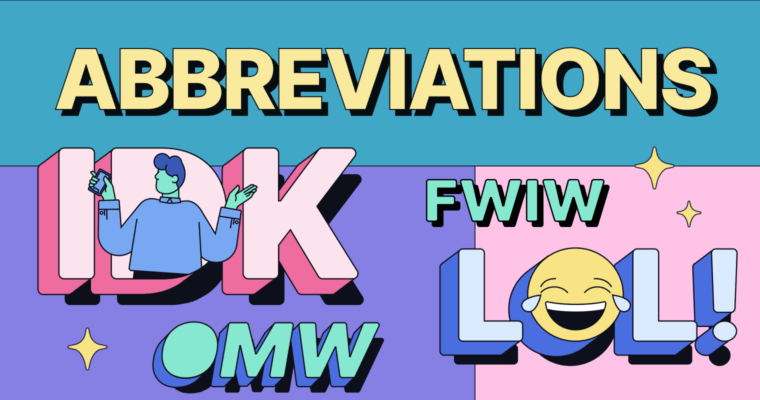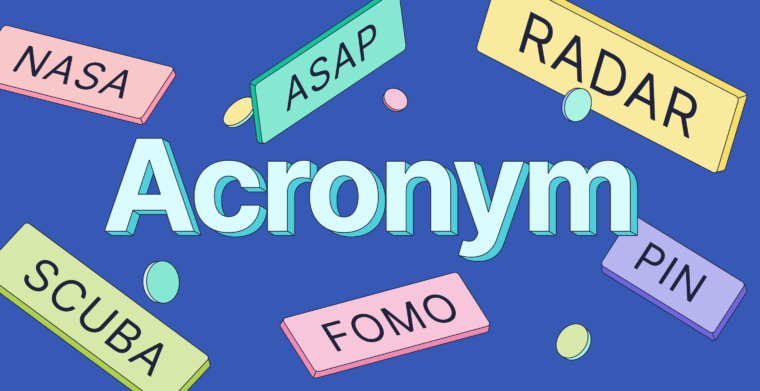
An abbreviation is a shortened form of a word or words; because there are different ways to shorten words, there are a few different types of abbreviations. For example, you could get rid of a syllable or two, create a contraction, or use the first letters of multiple words to create an entirely new word.
If you want to make an abbreviation, you have several options. In this guide, we explain the types of abbreviations, describe how they work, and provide plenty of abbreviation examples so you can see how it’s done.
What are abbreviations in English?
An abbreviation is just a short version of a longer word or a phrase. For example, the word ad is an abbreviation of advertisement, and the word don’t is an abbreviation of do not. Abbreviations are prevalent in both speaking and writing. They’re present in most languages as well, so abbreviations in English aren’t the only ones.
The purpose of abbreviations is to make communication more efficient by using smaller words. This is most apparent in acronyms, one of the types of abbreviations we discuss below. An acronym takes the first letter (or letters) of a set of words and adds them together to create a brand-new word. In this way, an acronym replaces a long string of words with just a single one, making communication that much easier.
Types of abbreviations: What are the 5 abbreviation types?
There are a few different ways to shorten words, and not all of them can be used on every word. Before we discuss the types of abbreviations individually, here’s a quick list of them so you know what to expect. We’ll describe how each of these terms is commonly used, but you should be aware that exact definitions sometimes vary.
1 Clipping: removing entire syllables to make words shorter
2 Contractions: removing certain letters to make words shorter, and sometimes combining two or more words, with missing letters replaced by an apostrophe
3 Initialism: combining the first letters of multiple words, with the result pronounced as individual letters
4 Acronyms: combining the first letters of multiple words, with the result pronounced as a new word
5 Textese (online slang): a modern form of communication that uses individual letters, numbers, and symbols to reduce typing time
Below we explain how each type of abbreviation works, including some common examples for each.
1 Clipping
Clipping refers to the removal of entire syllables from words, usually from the end. What’s left is typically one or two syllables that people can still easily recognize. Clipping is so common that often the abbreviation is much more popular than the full version of the word. It’s also frequently used with people’s names to create nicknames.
Clipping does not usually require additional punctuation. In formal writing like research papers, spelling out the entire word is preferred, and clipping is avoided; this often applies to contractions as well.
Clipping abbreviation examples
- ad (advertisement)
- exam (examination)
- app (application)
- rhino (rhinoceros)
- flu (influenza)
- Liz or Beth (Elizabeth)
2 Contractions
Contractions are one of the most common types of abbreviations. It involves removing individual letters, instead of entire syllables as in clipping. You might be familiar with contractions that use the apostrophe, like can’t or you’re, but these aren’t the only contractions.
A lot of contractions use punctuation to show that a word has been shortened, usually a period or apostrophe. Formal titles often use a period to form a contraction, such as Dr. for doctor, and months often do the same, like Jan. for January (which also incorporates clipping).
Contractions are also normal when writing addresses, like St. for Street or Apt. for Apartment. Typically abbreviations are used for proper names in addresses, whereas they are not used to replace words used generically. For example, it’s incorrect to write, “What st. do you live on?”
Not all contractions use punctuation, however. For example, cm for centimeter does not use any punctuation, while in stands for inches. The punctuation used with a unit of measurement is related to the style being followed, so always double-check the proper way to write a contraction if you are uncertain.
It’s also worth noting that some contractions use letters that aren’t even in the original word. For example, the contraction lbs. for the unit of mass pounds uses letters from the outdated Latin word libra.
Contraction abbreviation examples
- can’t (cannot)
- could’ve (could have)
- it’s (it is or it has)
- I’ll (I will)
- Mr. and Mrs. (Mister and Missus)
- Dr. (doctor)
- Jan. (January)
- Ave. (Avenue)
- Apt. (Apartment)
- pt (pint)
- in (inch)
- lbs (pounds)
- ft (foot or feet)
3 Initialisms
An initialism is simply the use of initials—using the first letter of a word to represent the entire word. Initialism is quite common for names, both of people and organizations, as a way to shorten long strings of words, especially in writing. For example, the author of The Lord of the Rings, John Ronald Reuel Tolkien, is more popularly known as J. R. R. Tolkien.
When speaking, pronounce initialisms by saying the name of each letter. This is the primary difference between initialisms and acronyms, with acronyms pronounced like words.
Initialisms may or may not use periods after the letters. Traditionally periods have been used to signal an abbreviation, such as U.S.A., but more modern writing tends to abandon the periods for the sake of brevity, as in USA.
If initials are used to abbreviate the entire name of a person, do not use periods; for example, if you’re abbreviating Martin Luther King, use MLK, not M. L. K.
Initialism abbreviation examples
- FBI (Federal Bureau of Investigation)
- UFO (Unidentified Flying Object)
- CEO (Chief Executive Officer)
- CCTV (Closed Circuit TeleVision)
- FDR (Franklin Delano Roosevelt)
- MBA (Master of Business Administration)
- FAQ (Frequently Asked Questions)
4 Acronyms
Just like initialism, acronyms combine the first letters of multiple words. However, the big difference is that these letters are pronounced together like a brand-new word, instead of saying each letter separately.
Abbreviations in English use acronyms more than you might think. For example, did you know the word laser is an acronym for Light Amplification by Stimulated Emission of Radiation? Acronyms like laser are used so often, people tend to forget the words they’re supposed to represent.
Acronyms can be either capitalized or lowercase, depending on the word. If you’re unsure about which form to use, consult a dictionary.
Acronym abbreviation examples
- PIN (Personal Identification Number)
- NASA (National Aeronautics and Space Administration)
- RAM (Random Access Memory)
- scuba (Self-Contained Underwater Breathing Apparatus)
- radar (RAdio Detection And Ranging)
- zip code (Zone Improvement Plan code)
5 Textese (online slang)
Last is the most recent addition to the types of abbreviations: online slang, or textese as it’s commonly known. Textese was born out of a need to speed up typing time on computers, mobile phones, and similar devices. The idea is to use minimal characters to represent words so you can send a message faster, such as typing U instead of you.
Textese is a broad term that covers any kind of typed communication, from phone texting to email acronyms. Textese draws on the other types of abbreviations, sometimes using initialism (irl for in real life), sometimes using contractions (bc for because), and sometimes inventing entirely new words by combining letters and numbers based on sounds (gr8 for great).
Because it’s a type of slang, there are no real grammar or formality rules—the more you practice it, the faster you learn it.
Textese abbreviation examples
- lol (laugh out loud)
- btw (by the way)
- imo (in my opinion)
- idk (I don’t know)
- wat (what)
- bc (because)
- wknd (weekend)
What are the top 10 abbreviations in English?
Here’s a list of ten of the most common abbreviations in English, loosely based on a list by Go Natural English.
1 don’t (do not)
2 can’t (cannot)
3 won’t (will not)
4 he/she/it’s (he/she/it is or has)
5 I’m, you/we/they’re (I am, you/we/they are)
6 I/you/we/they’ve (I/you/we/they have)
7 Mr. (Mister)
8 PM (post meridiem)
9 AM (ante meridiem)
10 ok (okay)





